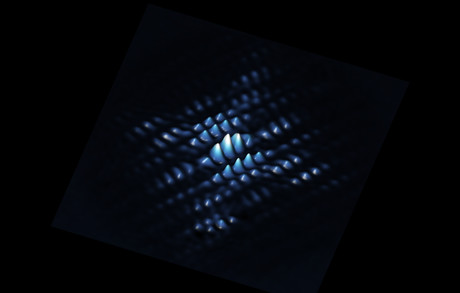Atom qubits 'talk' to each other for the first time

Australian researchers are creating quantum bits from precisely positioned individual atoms in silicon — and have recently succeeded in making two of these atom qubits ‘talk’ to each other for the first time.
Led by UNSW Scientia Professor Michelle Simmons, director of the Centre of Excellence for Quantum Computation and Communication Technology (CQC2T), the team creates the atom qubits by precisely positioning and encapsulating individual phosphorus atoms within a silicon chip. Information is stored on the quantum spin of a single phosphorus electron.
“In placing our phosphorus atoms in the silicon to make a qubit, we have demonstrated that we can use a scanning probe to directly measure the atom’s wave function, which tells us its exact physical location in the chip,” Professor Simmons said. “We are the only group in the world who can actually see where our qubits are.
“Our competitive advantage is that we can put our high-quality qubit where we want it in the chip, see what we’ve made, and then measure how it behaves. We can add another qubit nearby and see how the two wave functions interact. And then we can start to generate replicas of the devices we have created.”
For the new study, published in the journal Nature Communications, the team placed two qubits — one made of two phosphorus atoms and one made of a single phosphorus atom — 16 nm apart in a silicon chip. As explained by lead co-author Dr Matthew Broome, “Using electrodes that were patterned onto the chip with similar precision techniques, we were able to control the interactions between these two neighbouring qubits, so the quantum spins of their electrons became correlated.
“It was fascinating to watch,” said Dr Broome, formerly of UNSW and now based at the University of Copenhagen. “When the spin of one electron is pointing up, the other points down, and vice versa.
“This is a major milestone for the technology. These types of spin correlations are the precursor to the entangled states that are necessary for a quantum computer to function and carry out complex calculations.”
Lead co-author Sam Gorman added: “Theory had predicted the two qubits would need to be placed 20 nm apart to see this correlation effect. But we found it occurs at only 16 nm apart.
“In our quantum world, this is a very big difference,” said Gorman, a PhD candidate at UNSW. “It is also brilliant, as an experimentalist, to be challenging the theory.”

Scientists and engineers at CQC2T are at the forefront in the race to build a quantum computer in silicon, developing parallel approaches using single-atom and quantum-dot qubits. The team has chosen to work in silicon because it is among the most stable and easily manufactured environments in which to host qubits, and its long history of use in the conventional computer industry means there is a vast body of knowledge about this material.
In a recent paper published in the journal Nano Letters, the team used atomic-scale control techniques to produce quantum circuitry about 2–10 nm wide. Working in collaboration with Saquib Shamim and Arindam Ghosh of the Indian Institute of Science, the team managed to achieve the lowest recorded electrical noise of any semiconductor circuitry.
“Our results confirm that silicon is an optimal choice, because its use avoids the problem most other devices face of having a mix of different materials — including dielectrics and surface metals — that can be the source of, and amplify, electrical noise,” Professor Simmons said.
“With our precision approach we’ve achieved what we believe is the lowest electrical noise level possible for an electronic nano-device in silicon — three orders of magnitude lower than even using carbon nanotubes.”
In another recent paper in Science Advances, Professor Simmons’ team showed their precision qubits in silicon could be engineered so the electron spin had a record lifetime of 30 seconds — up to 16 times longer than previously reported. These long lifetimes allowed the researchers to read out the electron spins of two qubits in sequence with an accuracy of 99.8% for each, which is the level required for practical error correction in a quantum processor.
“The lifetime of the electron spin — before it starts to decay, for example, from spin up to spin down — is vital,” said Professor Simmons. “The longer the lifetime, the longer we can store information in its quantum state.
“The combined results from these three research papers confirm the extremely promising prospects for building multi-qubit systems using our atom qubits.”
Avoiding EMC issues: simple tests you can do yourself
This is a brief overview of EMC compliance with some practical tips on not getting caught out.
Electric dump valves help oil and gas company reduce emissions
Oil and gas company Laramie Energy deployed ASCO zero-emissions electric dump valves to comply...
Australia's largest electronics expo returns to Sydney
Electronex, the annual electronics design and assembly expo, will return to Sydney on 19–20...





